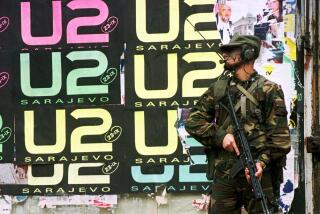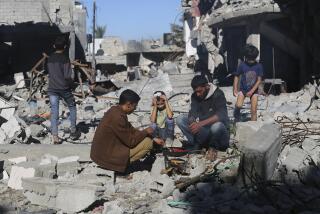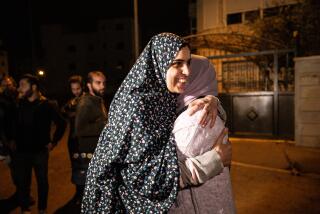Sarajevo Siege Ends as Suburb Trades Hands
ILIJAS, Bosnia-Herzegovina â The Bosnian Serb stranglehold on Sarajevo, perhaps the most enduring symbol of the fratricide that laid waste to the Balkans over the past four years, officially came to an end Thursday when this Bosnian Serb-held suburb reverted to government authority.
âI send this message with great pleasure to all citizens of Bosnia-Herzegovina and the whole world: The siege of Sarajevo has been lifted,â declared Avdo Hebib, interior minister of the Muslim-led Bosnian government.
The pronouncement was made as Muslim-Croat federation police dispersed through the streets of this largely deserted industrial town and, more significantly, took control of a strategic road that connects Sarajevo with the Bosnian towns of Zenica and Tuzla.
It was the first time since the start of fighting here in 1992 that access to the capital was not dictated by the Bosnian Serbs. They not only controlled land routes into the city--and thereby supplies of food, fuel and humanitarian relief--but also wreaked havoc at the airport with weaponry from neighboring suburbs.
âIt is great to be back,â said a neatly dressed Muslim police officer whose Ilijas home was reduced to rubble after he fled four years ago. âWe are going to make this place better than ever.â
Down the street, a retired Bosnian Serb railroad worker lashed a bicycle and stepladder to the side of a top-heavy truck, the final touches before heading out of town.
âI laid every single brick with my own hands,â said Relja Ostojic, 65, proudly showing off the house he was about to abandon. âI hope I will be back to sell it, but never to live. That is impossible now. The hatred is too big.â
The historic hand-over of authority, required by the Dayton, Ohio peace accord, came on the fourth anniversary of a plebiscite that led to Bosniaâs secession from Yugoslavia. That declaration of independence sparked a revolt by the Bosnian Serbs and the erection of the first barricades in Sarajevoâs streets, ultimately hurling the country into a war that killed 10,000 city residents.
This northwest suburb and the nearby highway were seized early on by the Bosnian Serbs and fiercely defended throughout the conflict.
âI wish that in the future we shall be less [Muslims], Croats, Serbs and Jews, and more citizens of Bosnia-Herzegovina,â Bosnian President Alija Izetbegovic said in a statement from his hospital bed, where he is recovering from a heart ailment. âWe still have a huge job to do, and it is up to us how and whether that important business will be done.â
Though fighting has stopped and the barricades are gone, the ongoing reunification of Sarajevo--all of the cityâs Serb-populated suburbs revert to government control by March 19--brings a hollow feeling to many residents.
Not only is the Sarajevo area experiencing one of its biggest ethnic population shifts since the start of the war as thousands of Bosnian Serbs flee the suburbs, but movement across the former confrontation line at the heart of the city remains a dicey proposition for both sides.
Departing Bosnian Serbs have been pelted with rocks, Bosnian police are summarily stopping motorists on major thoroughfares and, in a case fast becoming a symbol of the troubles, a news photographer was arrested three weeks ago while shooting pictures on the so-called Bridge of Brotherhood and Unity.
Bosnian freelance photographer Hidajet Delic, 48, who worked for BH Press of Sarajevo and Associated Press, has not been charged by the Bosnian Serbs, who are reportedly holding him in a shipping container in Pale, the Bosnian Serb headquarters east of Sarajevo.
Representatives of the Organization for Security and Cooperation in Europe, or OSCE, the U.N. International Police Task Force and the U.N. high representative for Bosnia have visited Delic. But they all have failed to secure his release.
âWe take it extremely seriously and see no excuse for his detention,â said Michael Maclay, spokesman for U.N. High Representative Carl Bildt.
Bosnian journalists, frustrated by the arrest, have tried to draw greater international attention to the photographerâs plight by demonstrating outside Bildtâs offices. On Thursday, they launched an indefinite blackout of news coverage of Bildtâs organization and the OSCE.
On a narrow street on a hillside above downtown Sarajevo, Delicâs mother sat in her living room Thursday waiting for news of her son, a special Bosnian dessert ready to serve should he show up unannounced.
Fatima Delic survived the siege of Sarajevo. Her home was severely damaged by a shell and she has a collection of sniperâs bullets fired at her while she was on her patio. But right now, she said, this new Sarajevo seems just as hard to bear.
More to Read
Sign up for Essential California
The most important California stories and recommendations in your inbox every morning.
You may occasionally receive promotional content from the Los Angeles Times.










